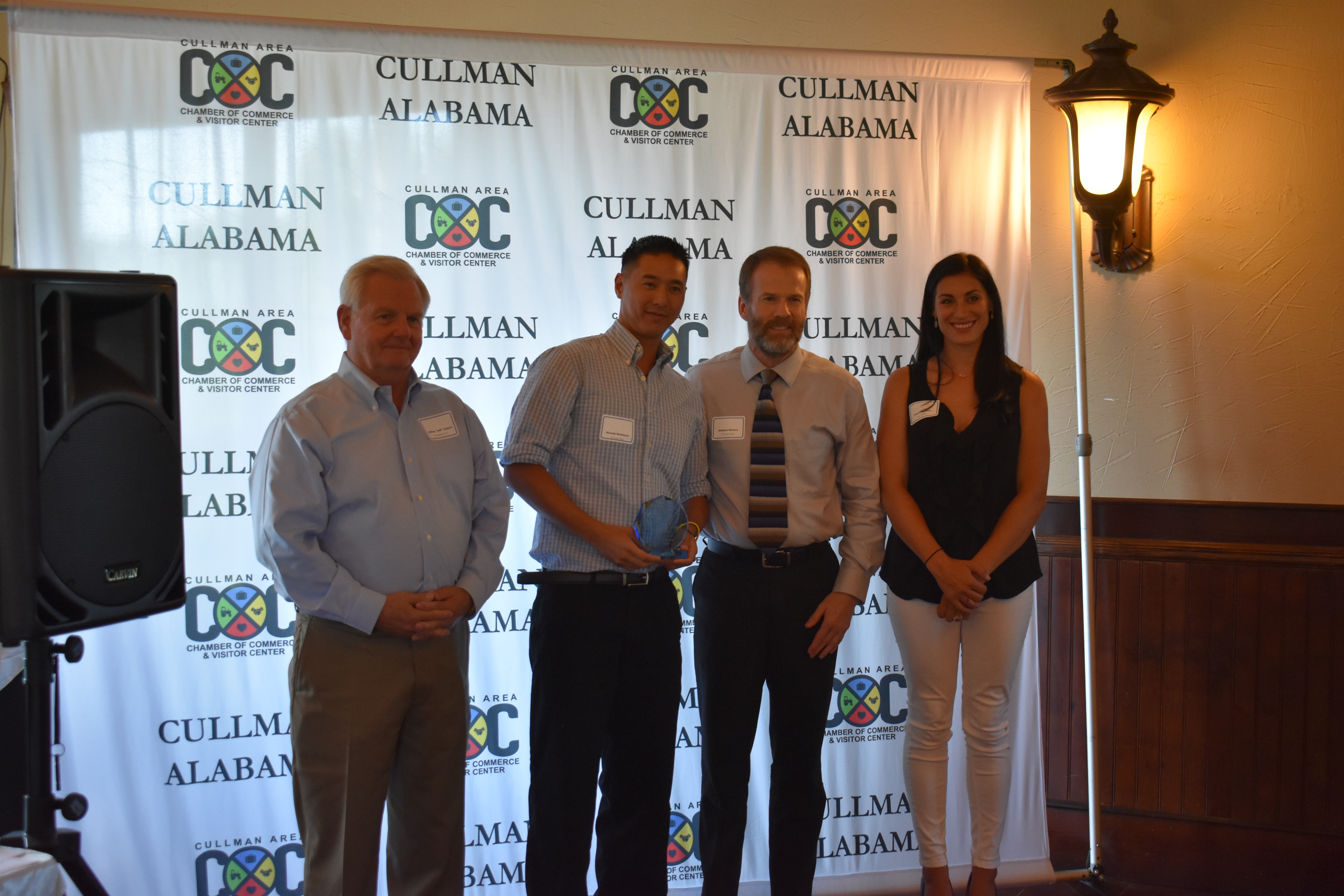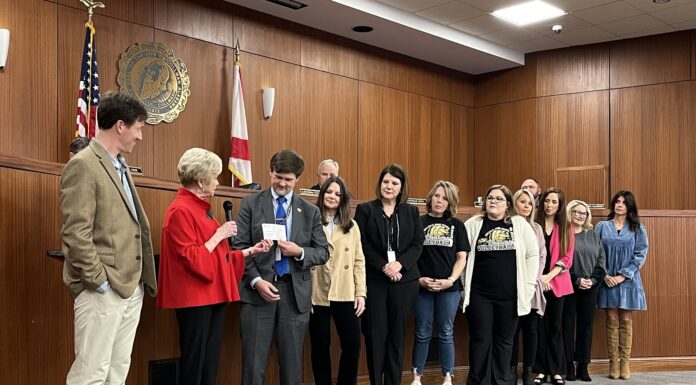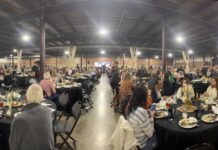CULLMAN, Ala. – In celebration of the achievements of the businesses and venues that have helped make Cullman County a more popular tourist destination, and to share the stories behind some of the most famous areas and events, the Cullman Area Chamber of Commerce & Visitor Center held their 6th Annual Awards Ceremony for Excellence in Tourism on Thursday morning.
Elected officials and corporate sponsors, as well as representatives from restaurants, hotels, and popular events and locations joined the Chamber and its Tourism Board bright and early at Stone Bridge Farms for the ceremony, which featured a catered breakfast and stories about three of Cullman’s most popular tourist destinations before the award presentations.
The story of the Ave Maria Grotto – Br. Paschal Pautler, St. Bernard Abbey
“128 years ago, a scrawny 13-year-old boy from Bavaria, in southern Germany, came to this country on a boat. He left his father, who was a brewer in Germany, and his stepmother (his mother died when he was young), and never went back to his homeland, never saw those parents again. That’s because he had a great dream. His dream was to come to America and be a priest, a great preacher of the gospel.
Well, tragically that didn’t happen. He had a deformity-once as a young boy, he was hurt and he was hunched over for the rest of his life. Because of that, he was not able to carry out that mission and go out and preach the gospel. He was stuck in a little monastery in Alabama shoveling coal in a powerhouse, really a tragic story. But out of that tragedy, he made something wonderful: he started making little miniatures, which is now known today as the Ave Maria Grotto. Some 120 years later, he’s done more preaching of the gospel than any other monk of St. Bernard Abbey ever has. So it’s amazing that, through his tragedy and determination, he left that country, came to America, and is one of the most famous sons Cullman has ever had.”
The story of Smith Lake – Roger Steele, Tourism Director
“In 1961, the dam on the Warrior River near New Hope was completed. It was expected to take weeks, maybe even months, for the reservoir-which would become Smith Lake-to fill up. However, it seemed as if the Lord had other plans. Rain fell so hard that it took just a matter of days for the water to cover the entire landscape. It’s funny, it seems like we had a repeat of this when the Duck River reservoir filled up a few years back in the exact same manner. I guess [it’s] just another reason to know that Cullman County really is truly blessed, and the Lord is watching over us.
Smith Lake, to me, represents a major step forward in the history of tourism in our area. Right from the beginning, it became a regional mecca for boating, skiing, fishing, and a number of tournaments in the 1960s. My personal memories of Smith Lake date back to the ’70s and early ’80s. I vividly remember my brother and I, when we got off work at the Dairy Queen, jumping in his 1978 white Thunderbird with a boat hitch on it, and towing an old ski boat to the lake. We normally launched at Smith Lake Park or Speegle’s Marina. We loved to ski all over the lake, especially on a weekday afternoon, as I recall, just after it rained. That was when the lake was absolutely smooth and was perfect for skiing. I remember jumping off rocks in the lake, these little mini cliffs, always admiring the castle, and also exploring streams that would run into the lake.Thinking back now, I sure was lucky to have such a magnificent body of water right next door to where we lived.
For me, Smith Lake represents a turning point in our story of tourism. It’s had a tremendous effect on all of us since its creation, but its tremendous potential still lies in the future. Certainly I believe that its story has not been completed, that’s for sure.”
The story of Rock the South – Shane Quick, Premier Productions, Rock the South
“Many people don’t realize that the idea for Rock the South actually started in 2008. I was walking around Heritage Park and I kept seeing that open field, and I kept having this vision of a country music festival in Cullman. I grew up going to June Jam up in Fort Payne. Me and my parents were the ones waiting with lounge chairs for them to open up the gates.
So we could run and get the best seats. I always felt like Alabama needed a major country music festival. If you look around and talk to people, it’s obvious that that’s what the people around here love. So in about 2008, I asked several people around the city and county. I said, ‘I got this dream.There’s something I wanna do. I wanna bring a country music festival to Cullman.’
We started meeting once a month at William’s BBQ and just started dreaming. I really came to a conclusion: we could invite the biggest bands in the world, we could promote this festival, we could really put the infrastructure together to build this festival; but we really needed a reason. Great festivals need a reason to come together. There has to be more than just songs and a concert and a stage. There has to be something bigger than that to make it great. Our company does twelve festivals a year across the country, and what we’ve seen over the years is that the ones that have a purpose, something deeper than music, actually survive.
April 2011 came and the tornadoes came through the city and the county, and Mayor Max [Townson] called and asked me to meet. We were thinking, ‘What do we do?’ We got this city that’s kinda torn apart, all these churches are working. You gotta remember the way we all came together in that moment. In a weird way-I know it’s kinda hard to say-but a tornado gave us one of the greatest moments in the history of our community. I saw churches coming together–I remember Desperation and Daystar feeding people, and First United Methodist, First Baptist, and the Pentecostals were working with the Catholics to take care of people–and I was looking around and realized I’m not really good at anything outside of pushing music, but Max asked me to put together an event.
The miracle of that event, a band called Casting Crowns, was [there]. It was Casting Crowns that pulled me out of a sawmill in Hanceville and allowed me to do what I do for a living around the world. It changed my life, so they had a deep impact on me and my life and my family already, but the lead singer’s wife actually grew up in Cullman. So just a few days after the tornadoes, we were all helping each other in the middle of the chaos, and Max thought we needed a break. He said, ‘People are tired. They need a reason to come together and just kind of rest for a moment.’ So we started looking for generators, and there were no generators in the state of Alabama, but we called a guy up in Indianapolis who said he’d be there in a few days. We found a stage, and all these things kinda came together. I called the lead singer of Casting Crowns and said, ‘This tornado hit Cullman. We wanna come together and have an event on Sunday. Our churches, our people, our community, our neighbors, they need rest. They need a reason to come together and support each other.’ He said they had an event in Memphis that would bring them through North Alabama Sunday morning, so they just pulled right on in. We had maybe 15,000 people and we raised $20,000. We gave all that money to the Red Cross because their building had been wiped out.
Our company will do over 600 events this year around the world, and we’ve been doing that every year for about fifteen years, but there is no event that I’ve ever been a part of, including all the Rock the Souths that we’ve been a part of, that can even touch the moment we had at the fairgrounds in 2011, just a few days after that tornado. It was one of the greatest moments of my career.”
After the stories had been shared, Tourism Chair Josh Wiggins came up to give a report on how tourism has been in the past year, as well as outline some plans for the future. Based on reports from businesses and event venues, the Chamber estimated around one million visitors to Cullman County in 2018, which is a significant portion of the 27 million visitors to the state estimated by the Alabama State Department of Tourism. Wiggins stated that the Chamber and Tourism Board will look to increase tourism rates further by increasing appropriate tourism infrastructure and expanding areas that have been previously unexplored.
One method of increasing tourism that Wiggins listed was analyzing hotel occupancy rates across the county and using them as a metric to measure how much tourism grows in a given month, year, or specific location. The data from 2018 indicated that the month for highest occupancy was June (over 70% of hotel rooms occupied), while the lowest month was December (less than 45% of rooms occupied). To help fill in the gaps between the high-occupancy months and low-occupancy months, Cullman hosted the 2018 Fishers of Men Southeast Region bass tournament last November and a Bassmaster regional college tournament in April of this year. The tournaments combined brought over 800 contestants and their families to Cullman during a typically low-tourism time of year, and also generated an estimated $750,000 in economic impact.
To help showcase Smith Lake’s potential as a premier bass fishing location, Wiggins announced that Cullman has secured three major bass tournaments for 2020: the 2020 Bass College Regional and the 2020 Bass High School Regional (both from Bassmaster) back to back, plus an Alabama Regional Tournament from Alabama Bass Nation. While these tournaments will help increase occupancy rates during slower months of the year, Wiggins also posed a question on how to increase general occupancy year-round in ways that wouldn’t take years to grow significantly. He then answered that the best way would be to take advantage of the tourist sites already popular in Cullman County, especially religious and agricultural sites.
Officials from the Ave Maria Grotto and the Shrine of the Most Blessed Sacrament estimate a total of 200,000 visitors to one or both sites each year, and Wiggins announced that officials from both sites have agreed to help the Tourism Board carry out a plan intended to double the number of visitors to the sites, while also directing visitors to local shops and restaurants. Other religious leaders from churches around the county will also join this plan, and the people involved will soon meet at a “Cullman Religious Tourism Roundtable” in order to brainstorm ideas that will benefit the entire community.
Wiggins also announced that the Board will be taking a similar approach to agricultural tourism, reaching out to people and businesses such as Rachel Dawsey from the North Alabama Agriplex Heritage Center, Travis Cress from Cress Farms, and Greg Anderson from Sullivan Creek Ranch for their ideas and perspectives. In order to get the process rolling, the Board is working on creating itineraries for farm tours, seasonal tours, agricultural heritage tours, and “You Pick It” farm tours. They are also working with local restaurants to help highlight locally-grown produce on their menus, and plan on working with the Festhalle for farmers’ market tours.
With these two areas of tourism promoted, Wiggins projected seeing an overall increase in tourism year-round instead of in specific months, stimulating Cullman County’s economy continuously while also giving annual events time to grow over several years.
The Awards, presented by Jeff Tolbert (Chamber Vice Chair for Tourism) and Emily Bussman (Tourism Board Treasurer)
Exceptional Festival or Event Award: Recognizes a festival or event that attracts visitors as well as locals, generates regional and/or state media attention, and positively promotes the Cullman area.
Nominees: Bloomin’ Festival, Second Fridays, & Strawberry Festival
Winner: Second Fridays
Best Attraction Award: Recognizes a regional attraction–including museums, performing arts, parks, amusement parks, etc.– which attracts visitors and contributes an outstanding tourism experience.
Nominees: Cullman Agricultural Trade Center, Clarkson Covered Bridge, Stony Lonesome OHV Park, & Cullman County Museum
Winner: Stony Lonesome OHV Park
Rockin’ Retailer: Recognizes a retailer that provides an outstanding shopping experience for visitors.
Nominees: Southern Accents, Jack’s Western Wear, & Mary Carter Store
Winner: Mary Carter Store
Extraordinary Everyday Eatery: Recognizes a restaurant offering an atmosphere that provides an outstanding experience for visitors.
Nominees: All Steak Restaurant, 412 Public House, & The Brandin’ Iron
Winner: 412 Public House
White Glove Award: Recognizes exceptional service from an individual hotel housekeeping staff member.
Winner: Peggy Doles, LaQuinta Inn
Silver Spoon Award: Recognizes consistent superior service by a restaurant or food service employee.
Nominees: Casey Jones (412 Public House) & Debbie Smith (Buffalo Wild Wings)
Winner: Debbie Smith, Buffalo Wild Wings
Savvy Retail Sales Associate: Recognizes excellent customer service from a retail sales associate who has first contact with the public.
Nominees: Sylvia White (NY Jewelers), Lyndsey Todd (Monograms Plus), & Melanie Chance (Yates-Chance Christian Bookstore)
Winner: Lyndsey Todd, Monograms Plus
Tourism Professional of the Year: Recognizes the person who has made a significant contribution to the tourism industry through five years or more of innovation, inspiration, and industry leadership.
Winner: Mother Angelica, Shrine of the Most Blessed Sacrament (received by Father Mathew Bartow and Pilgrimage Assistant Lizzie Bomback)


































